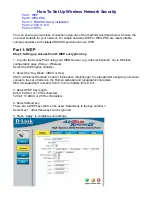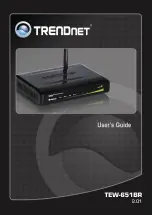
21
Chapter 5: Configuring the Wireless-G Broadband Router
The Wireless Tab - Wireless Security
Wireless-G Broadband Router with SRX400
The Wireless Tab - Wireless Security
The Wireless Security settings configure the security of your wireless network. There are five wireless security
mode options supported by the Router: WPA-Personal, WPA2 Personal, WPA Enterprise, WPA2 Enterprise, and
WEP. (WPA stands for Wi-Fi Protected Access, WEP stands for Wired Equivalent Privacy, and WPA Enterprise uses
a RADIUS (Remote Authentication Dial-In User Service) server. WPA is a security standard stronger than WEP
encryption. WPA2 is stronger than WPA. These options are briefly discussed here. For detailed instructions on
configuring wireless security for the Router, turn to “Appendix B: Wireless Security.”
Wireless Security
Select
WPA/WPA2 Personal
,
WPA/WPA2 Enterprise
, or
WEP
from the
Security Mode
drop-down menu. Then
proceed to the appropriate instructions. If you do not want to enable wireless security, select
Disable
.
WPA/WPA2 Personal
. Two WPA Personal options are available. To select WPA or WPA2 Personal, select
Enable
from the drop-down menu next to the desired option. WPA/WPA2 Personal gives you two encryption methods,
TKIP and AES, with dynamic encryption keys. Select the type of algorithm,
TKIP
or
AES
. Enter a Personal Key of
8-63 characters. Then enter a Group Key Renewal period, which instructs the Router how often it should change
the encryption keys.
WPA/WPA2 Enterprise
. This option features WPA/WPA2 used in coordination with a RADIUS server. (This should
only be used when a RADIUS server is connected to the Router.) Two WPA Enterprise options are available. To
select WPA or WPA2 Enterprise, select
Enable
from the drop-down menu next to the desired option. Then, select
the type of WPA algorithm you want to use,
TKIP
or
AES
. Enter the RADIUS server’s IP Address and port number,
along with an Enterprise Key shared between the Router and the server. Last, enter a Key Renewal Timeout,
which instructs the Router how often it should change the encryption keys.
Figure 5-18: Wireless Tab - Wireless Security (WPA/WPA
Personal)
Figure 5-19: Wireless Tab - Wireless Security
(WPA/WPA2 Enterprise)
IMPORTANT:
If you are using wireless security, always remember that
each device in your wireless network MUST use the same wireless security
method and shared key, or else the network will not function correctly. You
may mix between WPA and WPA2 Personal or WPA and WPA2 Enterprise,
but not between Personal and Enterprise, Personal and WEP, or Enterprise
and WEP.
encryption
: encoding data transmitted in a network
















































